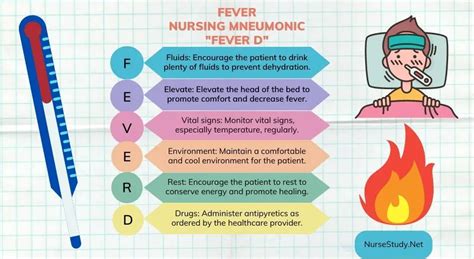Intro
High fever temperatures can be alarming. Learn about fever treatment, temperature control, and when to seek medical help for extremely high body temperatures, heat-related illnesses, and severe fever symptoms.
Having a fever can be a concerning and uncomfortable experience, especially when the temperature rises too high. A fever is a natural response of the body's immune system to an infection or illness, and it is usually characterized by an elevated body temperature, which can range from mild to severe. When the fever temperature becomes too high, it can lead to serious complications, making it essential to understand the causes, symptoms, and treatment options available.
Fever is a common symptom of various illnesses, including viral and bacterial infections, and it can affect people of all ages. In most cases, a fever is not a cause for concern and can be treated with over-the-counter medications and home remedies. However, when the fever temperature exceeds 103°F (39.4°C), it can be a sign of a more severe underlying condition that requires medical attention. High fever can lead to dehydration, seizures, and even brain damage if left untreated.
The importance of monitoring and managing fever cannot be overstated. Fever is a vital sign that can indicate the presence of an underlying infection or illness, and it is crucial to seek medical attention if the fever is extremely high, lasts for an extended period, or is accompanied by other severe symptoms. Furthermore, understanding the causes and symptoms of fever can help individuals take proactive steps to prevent and manage the condition, reducing the risk of complications and promoting overall health and well-being.
Understanding Fever

The symptoms of fever can vary depending on the underlying cause and the individual's overall health. Common symptoms of fever include elevated body temperature, sweating, chills, headache, and fatigue. In some cases, fever can be accompanied by other symptoms, such as cough, sore throat, and body aches. It is essential to monitor the symptoms of fever and seek medical attention if they worsen or persist.
Causes of Fever
The causes of fever are diverse and can range from common viral and bacterial infections to more severe conditions, such as sepsis and meningitis. Some of the most common causes of fever include: * Viral infections, such as influenza and respiratory syncytial virus (RSV) * Bacterial infections, such as pneumonia and urinary tract infections (UTIs) * Inflammatory conditions, such as appendicitis and peritonitis * Immunological disorders, such as lupus and rheumatoid arthritis * Cancer and its treatment, such as chemotherapy and radiation therapyDiagnosing Fever

Laboratory tests, such as blood cultures and complete blood counts (CBCs), may be ordered to help diagnose the underlying cause of fever. Imaging studies, such as X-rays and computed tomography (CT) scans, may also be used to visualize the affected area and rule out other conditions.
Treatment Options
The treatment of fever depends on the underlying cause and the individual's overall health. In most cases, fever can be treated with over-the-counter medications, such as acetaminophen and ibuprofen, which can help reduce the body temperature and alleviate symptoms. However, in some cases, more aggressive treatment may be necessary, such as antibiotics for bacterial infections or antiviral medications for viral infections.It is essential to follow the healthcare provider's instructions and take the prescribed medication as directed. Additionally, individuals can take steps to manage fever at home, such as:
- Staying hydrated by drinking plenty of fluids
- Resting and avoiding strenuous activities
- Using a cool compress or taking a cool bath to reduce the body temperature
- Avoiding overheating by staying in a cool, well-ventilated area
Complications of Fever

Prevention and Management
Preventing and managing fever requires a combination of good hygiene practices, a healthy lifestyle, and prompt medical attention when necessary. Some of the ways to prevent and manage fever include: * Practicing good hygiene, such as washing hands regularly and avoiding close contact with individuals who are sick * Getting vaccinated against common infectious diseases, such as influenza and pneumococcus * Avoiding overcrowding and poor ventilation, which can increase the risk of infection * Staying hydrated and getting plenty of rest to help the body recover from illnessConclusion and Next Steps

We invite you to share your thoughts and experiences with fever in the comments section below. Have you or someone you know had a high fever? What steps did you take to manage the condition? Share your story and help others understand the importance of monitoring and managing fever.
What is the normal body temperature range?
+The normal body temperature range is between 97.7°F (36.5°C) and 99.5°F (37.5°C).
What are the most common causes of fever?
+The most common causes of fever include viral and bacterial infections, inflammatory conditions, and immunological disorders.
How can I manage fever at home?
+You can manage fever at home by staying hydrated, resting, and using a cool compress or taking a cool bath to reduce the body temperature.
When should I seek medical attention for fever?
+You should seek medical attention for fever if the temperature exceeds 103°F (39.4°C), lasts for an extended period, or is accompanied by other severe symptoms.
Can fever be prevented?
+Yes, fever can be prevented by practicing good hygiene, getting vaccinated against common infectious diseases, and avoiding overcrowding and poor ventilation.
